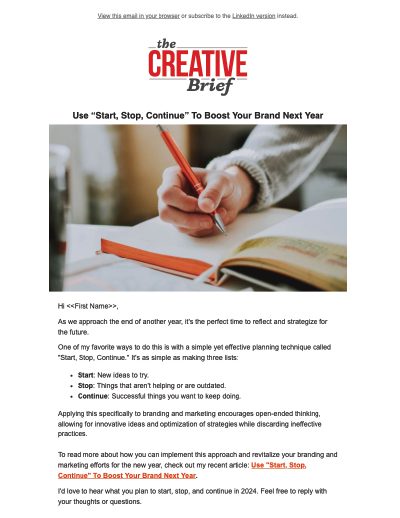Chances are you’re reading this because you received my newsletter this month in your inbox, and I linked to it on my blog. You may even have wondered, why haven’t I heard from Andy in a while? Well, you might want to check your junk folders for a few missed messages.
In November 2019, an article popped up in my feed About email marketing. It wasn’t the usual content marketing about, well, content marketing. This article was a technical guide about DKIM, DMARC, and SPF settings at the DNS level that will keep your content marketing emails from being marked as spam.
It took just ten minutes to update my DNS settings as instructed, and almost two weeks to fix the problem I created. This article is a cautionary tale of letting better get in the way of good enough. (insert the Law and Order “Da-Donk” sound here).
Down The Data Rabbit Hole We Go
Marketers use data to make strategic decisions related to reaching their target audience. According to Mailchimp, the average email open rate for my industry is 12%. The open rates on my email campaigns have historically been 35% on average over the last three years. So I should have been content with an open rate more than double the industry average, right? Well, I wouldn’t be much of a marketer if I didn’t at least try to improve the effectiveness of my campaigns at least a little bit.
I like to look at the Mailchimp analytics after we send out an email newsletter because I’m curious to see what kind of topics my subscribers want to read. I can also see if anyone unsubscribed, clicked on links, or if emails bounced, and I need to check the addresses (or remove them from my list). And yes, I’m also curious to see who is opening each email too. My list is small enough that I still personally know most of the subscribers on it.
It occurred to me that if 35% of my list is opening my emails, what about the other 65%? Why aren’t they opening my email newsletter? Could it be that my content isn’t interesting? Nah, that can’t be it. I know my email l must be going into their junk folders. “OK,” I said to myself, let’s make sure everyone is getting my email. I dug into the instructions, logged into my Domain registrar, and began typing.
DKIM, DMARC, and SPF Oh My!
DKIM, DMARC, and SPF are settings that aid in proving that email from you – like your newsletters and email campaigns sent from services like Mailchimp – is actually from you. Handled at your domain name settings (DNS) is an authentication method that tells mail servers it’s OK to let your email pass through to your recipients’ inbox. Anything sent from an unauthorized server gets labeled as spam. It can also, to some extent, prevent hackers from using your email for phishing messages, or otherwise hijack your email account.
So I followed the directions in the article, set the DKIM, DMARC, and SPF at my domain registrar and closed the browser. It took less than 10 minutes.
The very next edition of The Creative Brief had an open rate of less than 20%. While still better than the industry average, it was 15% lower than my norm. I asked a few friends on my list if they got my newsletter, and they reported that it went directly to the junk folder, even though it used to go to their inbox.
What is SPAM?
While SPAM might be a staple of the Hawaiian diet, email spam is any unsolicited and unwanted junk email sent in bulk to a mailing list. I had no idea why my email suddenly was marked as spam. My emails usually had a high open-rate. So I searched for answers on Google and found no shortage of articles on the topic.
One of the main reasons your email can go to the junk folder is that spam filtering has become more rigorous. Webmail providers like Gmail, Yahoo, and Outlook, are cracking down on spam.
Here are a few common reasons your email can be flagged as spam:
- Your email violates CAN-SPAM. The CAN-SPAM Act is a law passed in 2003 that sets national standards in the U.S. for commercial email. The FTC has published the CAN-SPAM act compliance guide that highlights the main requirements and outlines non-compliance issues that can get you into trouble. Some areas it touches on include: not using a deceptive email subject line, including a physical mailing address, telling recipients how to opt-out, and honoring opt-out requests within ten days.
- You used spam trigger words: Some spam filters are also triggered by certain words in the subject line or body of the email. Words like congratulations, free, order now, winner, click here, and yes, “this is not spam” are examples of trigger words.
- You included attachments: Another trigger for spam filters is attachments, which can carry computer viruses and malware. Additionally, they can slow down the load time of your message if the size of the file is large.
Reputable email services providers like Mailchimp, Constant Contact, and Drip have a system in place to catch most of the main requirements of CAN-SPAM before your message even goes out. These systems are in place this because email marked as spam that comes from their servers could compromise their server IP address. This would then cause ALL of the emails from their IP to be labeled as spam, affecting everyone on the platform. So I know compliance wasn’t my issue.
I don’t include attachments in my email marketing (I don’t think you can with Mailchimp). So I know that wasn’t the issue either.
I went and looked back at all of my recent messages, and I didn’t use any spam trigger words either. Another issue checked off the list.
The refresher course in email marketing compliance and best practices aside, the problem of my email going to spam was still not solved.
I’d Like To Call A Friend Please, Regis.
I was preparing some new email campaigns, and as usual, sent myself some tests to review how it looked. I clicked the button and waited for it to appear in my inbox. Except it didn’t. I sent another test, and again nothing got delivered. I sent the test to a few friends (with permission) and even my wife (who gets a lot of email from me). Nothing. Nada. Zip.
Then it hit me, check the junk folder. And there the emails were. Several copies of my draft campaign with [TEST] in the subject line. My friends told me all of my Mailchimp-produced emails were in their junk folder too.
I called my friend David at Ventropy Media, who handles all of my SEO and is a bonafide Google Analytics genius for some help in figuring all of this out. He introduced me to MXtoolbox.com, a website that boasts having a “supertool” that checks your DNS settings for errors. MXtoolbox helped me diagnose the problem, but I didn’t know how to fix it. Google also has its a tool, G Suite Toolbox/Check MX, that performs many of the same tests, and can also indicate what was causing the problem. So I entered my domain into the text field, and clicked “run Checks!”
And there it was. A misconfiguration of the SPF setting – in my case, one extra text character…yes, a typo – was the cause of my email campaigns being delivered directly to the junk folder of my subscribers. One little mistake in my SPF setting that made email servers think someone was sending unauthorized email from Mailchimp as me.
I Fixed the Glitch!
After I deleted the extra letter in the SPF setting, the open rates of my emails went back up. And yes, they even tick a bit higher now then they did before. But did I need to set DKIM, DMARC, and SPF for that small improvement? No, not really.
After all the research I did during those two weeks, I learned a lot about the technical workings of email servers, email marketing, and DNS settings. The truth is DMARC, DKIM, and SPF settings are useful in helping servers identify authorized mails servers sending on your behalf. And they could even improve your email deliverability if you set it up correctly.
Which I most certainly did not.




